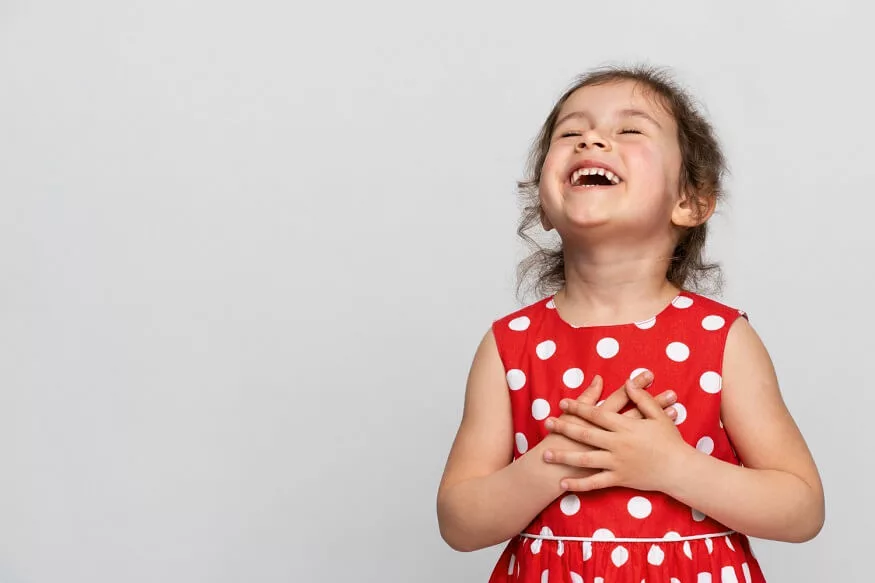Laughter, often considered the universal language of joy, holds profound significance in the realm of child wellness. As children navigate the challenges of growing up, laughter emerges as a potent elixir for their physical, emotional, and social well-being. This article explores the multifaceted benefits of laughter for children and delves into the world of humour activities that contribute to their holistic development.
Benefits of Laughter for Children
Physical Health
Laughter, it is said, is the best medicine. This adage holds true for children as well. Physiologically, laughter triggers the release of endorphins, the body’s natural feel-good chemicals, promoting an overall sense of well-being. Additionally, it enhances cardiovascular health by improving blood flow and reducing stress hormones. A hearty laugh can be compared to a mini-workout, engaging various muscle groups and boosting the immune system, thus fortifying a child’s defence against illnesses.
Emotional Resilience
Children face a myriad of emotions as they navigate the complexities of childhood. Laughter becomes a powerful coping mechanism, providing an emotional release and alleviating stress. It fosters emotional resilience by teaching children to approach challenges with a positive outlook. The ability to find humour in adverse situations can be a valuable life skill, aiding in the development of a well-rounded and emotionally intelligent individual.
Social Connection
Laughter serves as a universal language that transcends cultural and linguistic barriers. In a social context, it acts as a bonding tool, facilitating connections between children. Shared laughter creates a sense of camaraderie, fostering friendships and a positive social environment. Furthermore, a child’s ability to understand and share humour enhances their social intelligence, a crucial aspect of navigating relationships throughout life.
Cognitive Development
Humour stimulates cognitive development by encouraging creativity and problem-solving skills. Engaging in playful banter or enjoying a humorous story can stimulate a child’s imagination and critical thinking abilities. This intellectual stimulation lays the groundwork for effective learning and helps children approach academic challenges with a positive mindset.
Also Read: How does parental influence affect child development?
Humour Activities for Children
Here are some humour activities for children:
- Playful Storytelling
- Laughter Yoga for Kids
- Jokes and Riddles
- Improv Games
- Comedy Shows and Movies
- Silly Dance Parties
- Comic Strip Creation
- Puppet Palooza
- Wordplay Games
- Whimsical Arts and Crafts
Engage children in the enchanting world of storytelling infused with humour. Whether through reading funny books or creating whimsical tales, storytelling not only stimulates a child’s imagination but also introduces them to the joy of laughter in a narrative context. Encourage children to invent their own humorous stories, fostering creativity and language development.
Adapting the principles of laughter yoga for children can be a delightful and energising activity. Incorporating playful laughter exercises into their routine promotes physical activity, enhances mood, and introduces the concept of intentional laughter. This structured approach combines laughter with simple movements, making it an enjoyable group activity for children.
Introduce children to the world of jokes and riddles, igniting their sense of humour. This not only entertains but also encourages cognitive processing as they decipher punchlines and wordplay. Encourage them to share jokes with friends and family, promoting social interaction and boosting their confidence.
Improv games provide a platform for children to explore their creativity and spontaneity in a humorous context. Games such as “Yes, And…” or “Story Circle” encourage collaboration, quick thinking, and, most importantly, laughter. These activities not only entertain but also build confidence in expressing oneself through humour.
Selecting age-appropriate comedy shows or movies can be a delightful way for children to experience the joy of laughter. Whether through animated comedies or family-friendly sitcoms, exposure to humour in various forms contributes to their understanding of comedic timing, different styles of humour, and the importance of laughter in daily life.
Transform ordinary moments into extraordinary ones by introducing spontaneous silly dance parties. Crank up the music and encourage children to let loose, embracing their inner comedians through goofy dance moves. This not only promotes physical activity but also cultivates a carefree attitude, allowing children to express themselves creatively while sharing infectious laughter with friends and family.
Also Read: What Is Peekaboo? How To Play Peekaboo And Its Benefits
Unleash the budding artist within by engaging children in comic strip creation. Provide them with paper, markers, and a dash of imagination to craft their own humorous stories. This activity not only hones artistic skills but also encourages children to think visually and sequentially. Sharing their creations with others adds a social dimension to the fun, as friends and family enjoy the laughter-inducing narratives.
Bring the world of puppets to life and let the giggles ensue. Whether using sock puppets, hand puppets, or even homemade paper bag puppets, children can create whimsical characters that engage in comical conversations and adventures. Puppetry enhances communication skills, encourages storytelling, and fosters a lighthearted atmosphere that resonates with the infectious joy of laughter.
Stimulate linguistic creativity with wordplay games that tickle the funny bone. Engage children in activities like creating puns, playing tongue twisters, or inventing silly rhymes. These games not only enhance language skills but also foster a love for the nuances of communication. As children play with words, they discover the joy of language and the laughter it can evoke.
Turn everyday arts and crafts into a laughter-infused extravaganza. Encourage children to create humorous drawings, paintings, or sculptures that tickle their fancy. The process of artistic expression coupled with the joy of crafting amusing creations becomes a therapeutic and entertaining activity. Displaying these masterpieces proudly adds an element of pride and accomplishment, reinforcing the positive impact of laughter on well-being.









